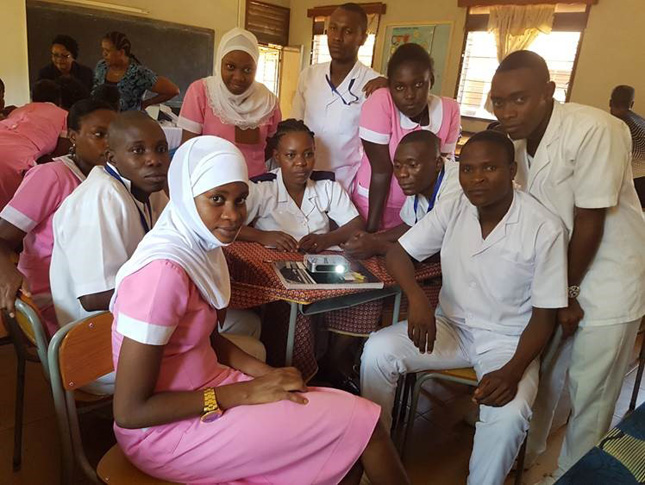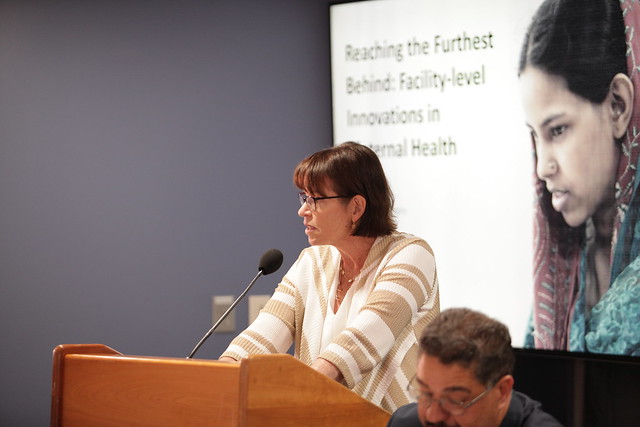-
Reaching the Farthest Behind: Maternal Health Innovations at the Facility Level
October 2, 2017 By Yuval Cohen
“Innovation happens when there are pioneers that stick with it,” said Monica Kerrigan, vice president of innovations at Jhpiego. “How can we—each one of us—be part of the change process?” Innovations will be essential to meeting Sustainable Development Goal #3, which is to reduce the global maternal mortality ratio to below 70 deaths per 100,000 live births. Experts from the United Nations Population Fund (UNFPA), Jhpiego, Jacaranda Health, and Total Impact Capital came together at the Wilson Center on September 14th to discuss how maternal health clinics and other facilities can be drivers of innovation.
The first step in serving the most vulnerable populations, Kerrigan said, is “to look at where we want to be in the future. We are not going to be there today—and that is part of innovations.”
Empowering Patients and Nurses: Innovations in Care
“Improving facility-based quality of care…that’s really the heart of the work we do,” said Nick Pearson of Jacaranda Health, a group of small-scale service providers in Nairobi, Kenya. In Kenya, the percentage of women delivering in facilities has risen from 40 percent to 60 percent in the last five years. “It is a step in the right direction,” Pearson said, but the quality of maternal health care in most facilities “is still grossly subpar.”
Jacaranda’s small maternity hospital on the outskirts of Nairobi emphasizes patient-centered care and empowering nurses, developing new systems and processes to deliver care affordably. “To drive quality care,” Pearson said, “you need nurses that are empowered, that are well-trained, and that are engaged.”
“To drive quality care you need nurses that are empowered, that are well-trained, and that are engaged.”Jacaranda develops innovations in group-based care based on the creative minds of their own patients. For example, mothers took the initiative to create online group chats that Jacaranda’s nurses then joined, turning them into a consistent facet of Lamaze programs. Innovations and designs are constantly reshaped based on the feedback of their patients and their partners.
Jacaranda’s innovations are sustainable, too: The average cost of delivery at the Jacaranda hospital is about 100 US dollars, which is roughly how much the Kenyan government subsidizes private and public hospitals for delivery.
Falling in Love With the Problem: Innovations in Data and Training
Using data effectively is crucial when developing and revamping innovative programs. For example, the ePartogram, developed by Jhpiego and tested in Kenya and in Zanzibar, Tanzania, is a tablet that facilitates clinical decision making and analyzes data to monitor programs and facilities. The challenge is actually using this data, said Kerrigan, to evaluate solutions and change them accordingly. “Can we fall in love with the problem,” she said, “before we jump into doing things?” When innovators “fall in love with the solution,” she said, they forget that changes are constantly needed.
Improving training for health personnel, while at the same time avoiding taking them away from patients, is also a challenge that needs innovation. Low Dose High Frequency Training, a model developed by Jhpiego, reshapes training to better utilize time, save money, and provide adequate learning models for providers. “We can’t just keep on doing classroom training…taking people out of their jobs and putting them in a classroom to learn,” Kerrigan said, “so how can we think about these more targeted spurts of training that would allow people to learn faster, better, more affordably, and sustainably?”
If we can “show something that works, money will come”To enhance trainings for birth attendants, UNFPA developed the Portable Mobile Learning System (MLS), a handheld projector with pre-downloaded training modules that can be used without being connected to the web. “It is highly cost effective—the total cost of this is about $600,” said Geeta Lal from UNFPA, “and it can be used for any kind of training.” Piloted in 2016, the MLS has been used to teach more than 3,000 beneficiaries in more than 100 training sessions, garnering significant interest from governments and ministries. If we can “show something that works, money will come,” said Lal.
Financing Change: Innovative Investment Vehicles
While innovative products can show tangible results fairly quickly, innovative designs and processes are not always the most attractive investments, as they need long-term financial support to be sustainable. “Public resources…are being extraordinarily constrained,” said John Simon, a founding partner of Total Impact Capital (TOTAL). “How do you create investment vehicles that can attract private capital into the types of innovations that [the speakers] are talking about?”
“The challenge,” Simon said, “is if you are trying to serve a person in Kenya who has $100 or less to spend on maternal care…that’s a market that straight commercial capital is not likely to look into.” Through the establishment of the Medical Credit Fund, TOTAL works with banks to allow them to fund innovations that improve the quality of health facilities. Initially, the Medical Credit Fund covers all of the risk, and gradually shifts the risk to banks. Banks, with the support of the fund, lend to facilities with sustainable models for improvement and a strong demand for their services. “At the end of the day, the most important thing is that you have something really innovative, that you can scale,” said Simon, “I don’t think there is a shortage of that…but I think connecting it with the capital will make it happen.”
Technological advancements are crucial, but innovative ideas for scaling up existing solutions and for improving training of care providers are key to increasing the quality of maternal and child health care. The field is filled with opportunities, from new devices to refurbished business models. While all of these efforts require money, impact investing and other financial innovations may fill the gaps in public sector funding. The maternal health community should remain focused on fixing the problem, not on fixing the solution. “[If] you hit one wall, there’s always an opening,” said Lal, “don’t give up.”
Event Resources:
Sources: Jacaranda Health, Jhpiego, Total Impact Capital, United Nations Population Fund
Photo Credit: UNFPA Tanzania Country Office
Topics: Dot-Mom, featured, From the Wilson Center, global health, health systems, Kenya, maternal health, media, Tanzania, video
 A Publication of the Stimson Center.
A Publication of the Stimson Center.




